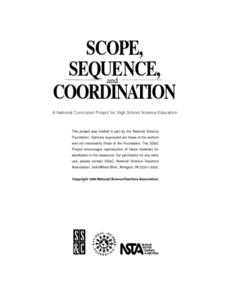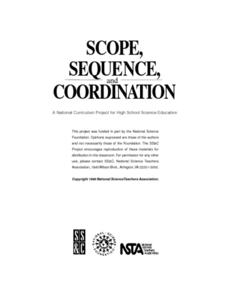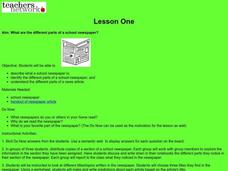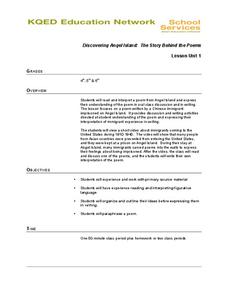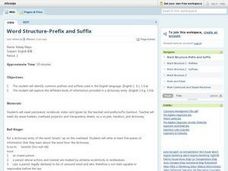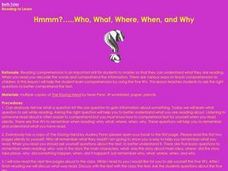Curated OER
Physical Properties of Matter
Five fabulous procedures introduce physics or chemistry classes to special properties of matter. They discover adhesion and cohesion, solubility, melting and boiling points, and viscosity through hands-on experiences. Tests are...
Curated OER
Observing Chemical Reactions
Start this series of lessons with a bang! Five exothermic reactions are outlined in this resource, including a demonstration that produces both light and sound. In the lab, chemistry apprentices record temperature changes, make hand...
Curated OER
Fossils and Lithologic Units
Practicing paleontologists map the geologic time scale, simulate the formation of sedimentary rock, and analyze fossil data. Instructions for four activities and five assessment choices are provided for the teacher. This comprehensive...
Curated OER
Qualitative Aspects of Rotational Dynamics
Explanations for six different physics lab activities and five suggested assessments are contained in this resource by the National Science Teachers Association. Any combination can be used to open learners' eyes to rotational motion....
Curated OER
Magnetic Induction
Physicists of the future observe the behavior of current in relation to a magnet through several inquiry activities. They construct a generator and experiment with solenoid coils. They learn and apply electromagnetic laws, most often...
NASA
The Electromagnetic Spectrum
Did you realize the visible light spectrum is less than three percent of the electromagnetic spectrum? A hands-onlesson includes five activities and experiments for scholars to explore and discover many advanced science concepts. They...
Core Knowledge Foundation
Unit 6: American Revolution
The American Revolution is the theme of a five-week unit that focuses on reading, grammar, morphology, and writing. Scholars read and respond to texts, practice spelling and word work, and write paragraphs. Assessments gauge comprehension.
Curated OER
Genetics 5 Technology
Learners, after studying extraction and gel electrophoresis, recombinant DNA, transgenic organisms, and reproductive cloning, summarize the main concepts in DNA technology. They analyze the applications of DNA: forensics, medicine,...
Curated OER
Cell 5 Diffusion and Osmosis
Students distinguish between active and passive transport. Students identify key words associated with active and passive transport. They draw and explain the structure f the cellular membrane. They are able to define phospholipid...
Curated OER
Ecology 5 - Carbon and Oxygen Cycles
High schoolers construct their own diagrams outlining the pathway of carbon and oxygen in our atmosphere. They listen to a lecture on the carbon cycle while drawing an example of the carbon cycle on the board. Students comprehend that...
Curated OER
Let the Games Begin!
Third graders use K-W-L charts to brainstorm a list of questions they would like to answer about sports. While visiting a Web site, 3rd graders research a chosen sport and complete their K-W-L chart.
Curated OER
Who, What, When, Where And Why is He There?
Students examine the process of asking the 5 W questions in order to increase their reading comprehension while reading non-fiction passages. They review silent reading techniques before listening to a teacher read aloud, and discussing...
Curated OER
The Who, What, When, Where, and Why of Reading
Students work to develop comprehension strategies. They focus on the five 'w' questions for summarizing: who, what, when, where, and why? Through modeling and guided practice, they apply these questions to summarize several passages.
Curated OER
Cool Tools to Solve Challenging Word Problems
Young scholars solve math word problems. In this cool tools lesson, students are introduced to the K-N-W-S method. Young scholars work in groups and complete a worksheet using this method of learning.
Curated OER
School Newspaper
Students analyze the different parts of a school newspaper. In this newspaper lesson, students complete a semantic web activity for newspapers and explore a newspaper in groups. Students create a write a report for the information....
Curated OER
What George Bush Got Right
In this George W. Bush worksheet, students read a 4-page article about the diplomatic actions of the president and then complete the provided graphic organizer.
Curated OER
What's So Important?
Students work to develop comprehension strategies. They focus on the five 'w' questions for summarizing: who, what, when, where, and why? Through modeling and guided practice, they apply these questions to summarize several passages in...
California Department of Education
Me and My Career
Your career search starts here! Sixth grade scholars begin their journey toward college and career readiness in the first of a five-part series of lessons. Individuals identify where their interests lead them using the Holland code, then...
Curated OER
Discovering Angel Island: The Story Behind the Poems
Poems carved into the wooden walls of the Asian immigrant prisons on Angel Island provide upper elementary graders an opportunity to study not only the story behind the poems but to also focus on the figurative language employed by the...
Curated OER
Word Structure- Prefix and Suffix
Identify common prefixes and suffixes used in the English language and categorize the different kinds of information provided in a dictionary entry. Learners will write at least five pieces of information that they learn about a word...
Curated OER
Stately Statements
Students closely read President Bush's State of the Union address, then develop interviews and write articles to assess a variety of points of view about The proposals offered in the speech.
Curated OER
SATP Informative Essay I
Students explore the basic steps of writing an informative five paragraph essay. Using a hamburger as an analogy, students discuss the five part method of writing and, given blank hamburger sheets, they fill in the main parts of the...
Curated OER
Hmmm...Who, What, Where, When, and Why
Pupils practice reading comprehension by answering the 5 "W" questions. After reading "The Kissing Hand," they complete a class discussion addressing the questions who, what, when, where, and why. Students choose an appropriate,...
Curated OER
Solving Mysteries!
Learners solve a mystery. In this lesson on journalism, students learn how writing an article is like solving a mystery by answering the 5 "W" questions. Learners solve a mystery provided to them on an attached worksheet.




